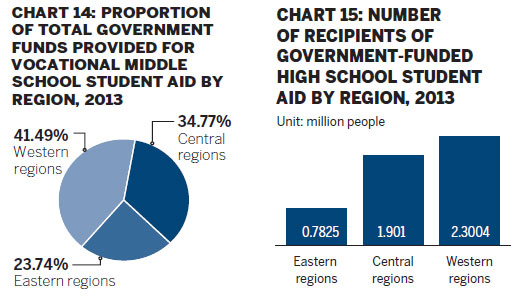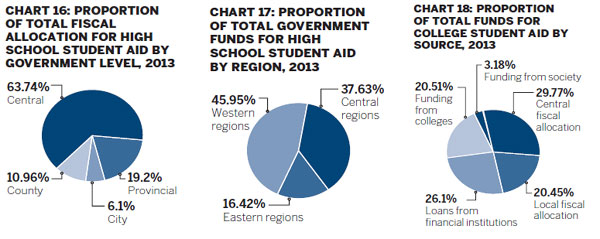China Student Aid Development Report 2013
Educational equity is an important foundation of social equity, and equal opportunity is essential to educational equity. The Chinese government has been paying great attention to equal schooling for students from impoverished families.
In 2013, the national student financial aid system in China was further enhanced with a new program to subsidize postgraduate students.
In 2013, a total of 118.5 billion yuan was spent on subsidizing preschool education, compulsory education, secondary vocational education, high school education and higher education, an increase of 5.9 billion yuan, or 5.25 percent, from 2012.
More than 4 billion yuan was used to subsidize preschool education, up 1.67 billion yuan, or 70 percent, from 2012. About 16.85 billion yuan was put into school boarding for students during compulsory education, a drop of 683 million yuan, or a 3.9 percent.
About 10.74 billion yuan was used to subsidize high school students, an increase of 1.38 billion yuan, or 14.7 percent. Subsidies for students at secondary vocational schools cost 29.46 billion yuan, up 919 million yuan, or 3.22 percent. Spending on subsidizing students at higher education institutions was 57.4 billion yuan, an increase of more than 2.6 billion yuan, or 4.8 percent compared with 2012.
Government funding, amounting to 80.5 billion yuan, accounted for 68 percent of the whole subsidy package. More than half of the government funding, about 42.8 billion yuan, came from the central government. Almost 37.8 billion yuan came from local governments.
In addition to government funding, about 38 billion yuan came from other sources, which comprised 32 percent of the whole. Student loans from financial institutions supported by the government reached about 15 billion yuan, 12.6 percent of the total. Subsidies from schools and other social and individual donations reached about 23 billion yuan, 19.4 percent of the total.
Subsidies for free textbooks and student nutrition programs cost 34.9 billion yuan in 2013, with more than 24.2 billion yuan coming from the central government and nearly 10.7 billion yuan from local governments. A total of 126 million primary and middle school students in the country benefited.
1. Preschool education
Under the policy that local governments are the primary sources of financial aid and the central government provides subsidies as rewards to them, preschool-age children from impoverished families, children with disabilities and orphans enrolling in kindergartens can receive financial support.
In 2013, nearly 3.52 million children in kindergartens received financial support from various channels. More than 3.3 million of them were supported by the government. About 175,800 are supported by kindergartens and 31,600 received charitable donations. The sum of all subsidies reaches nearly 4.1 billion yuan, an increasing of almost 1.67 billion yuan, or about 69.8 percent, from 2012. Some 3.857 billion yuan came from the government, 154 million came from kindergartens and 44 million from charitable donations.
1) Aid from governments:
In 2013, government at all levels helped more than 3.3 million children - about 9.37 percent of all children at kindergartens nationwide - with financial subsidies. In western China, about 2 million children received financial aid, accounting for almost 20 percent of all enrollment. In central China, 598,600 children received financial aid, about 4.6 percent. About 732,600 children received financial aid in eastern China, more than 5.9 percent of the total enrollment.
In 2013, 3.86 billion yuan was used as financial aid for preschool education by governments at all levels, an increase of 1.31 billion yuan, or 51.3 percent, from 2012.
More than 20 percent of the money, or 820 million yuan, came from the central government. About 1.64 billion yuan, or 42.6 percent, was from provincial-level governments. About 462 million yuan, or 12 percent, was from city-level governments. Some 932 million yuan, or 24.2 percent, came from county-level governments.
Viewed by region, about 61.6 percent, or 2.37 billion yuan, in financial aid from government for preschool children was spent in western China. About 15.17 percent, or 585 million yuan, was used in central China. About 23.28 percent, or 898 million yuan, was spent in eastern China.
2) Aid from kindergartens
In 2013, about 154 million yuan was set aside from the revenue of kindergartens to support 175,800 children. About 36 million yuan was spent in western China to help 53,700 children. About 52 million yuan was spent in central China for 76,900 children. About 66 million yuan was spent on eastern China to help 45,200 children.
3) Aid from society:
In 2013, 31,600 children in kindergartens received more than 43.9 million yuan in charitable donations from companies, communities and individuals. About 6,800 children in western China received 23.2 million yuan. About 9,300 in central China received 8.6 million yuan. And 15,500 children in eastern China received about 12 million yuan.
2. Subsidies for students in compulsory education ( grades one to nine)
The government provides free education for all students at the compulsory education stage, and offers free textbooks for rural students and students from impoverished urban families. The government also distributes free Chinese dictionaries to rural students, provides subsidies for boarding students from impoverished families and provides nutritious meals for students in impoverished areas.
More than 109 million students received a free Chinese dictionary in the spring semester in 2013 while 126 million students at the compulsory education stage benefited from the nation's free textbook policy. About 79.6 million students benefited from the local government's free textbook policy. Some 15.5 million students from impoverished families were subsidized. Students from impoverished families who board at school received about 16.85 billion yuan in subsidy. About 15.8 billion yuan from both central and local governments was spent on free textbooks to students. Local governments spent 2.19 billion yuan on free textbooks.
1) Free textbooks provided by the central government:
In 2013, more than 126 million students at compulsory education stage received free textbooks, 85.6 percent of the total number receiving books, 4 million fewer than in 2012, partly due to decreasing enrollment in 2013. By region, more than 38.30 million students, or 86.24 percent, in western China benefited from the free textbook policy. The number of students benefiting from the policy was more than 47.5 million - 83 percent - in central China and 39.9 million - 92.7 percent - in eastern China.
About 15.8 billion yuan was spent on providing free textbooks, 343 million yuan less than in 2012. About 13.1 billion yuan, or 83 percent, came from the central government. About 1.54 billion yuan, or 9.77 percent, was from provincial-level governments. About 528 million yuan, or 3.34 percent, was from city-level governments. About 615 million yuan, or 3.9 percent was from county-level governments.
By region, about 4.47 billion yuan, or 28.3 percent, was spent in western China. About 5.76 billion yuan, or 36.5 percent, was spent in central China. About 5.6 billion yuan, or 35.2 percent, was used in eastern China.
2) Free textbooks provided by local governments:
In 2013, more than 2.19 billion yuan was provided for subsidizing free textbooks by financial departments of local governments to 79.6 million students. These include more than 29.7 million students in western China, 66.8 percent of the region's student number; 31.6 million students in central China, 55.1 percent of the total number; and 18.3 million students in eastern China, 42.5 percent of the total number.
The amount of money spent on subsidizing free textbooks for students in western, central and eastern China are 649 million yuan, 452 million yuan and 1,089 million yuan respectively. All students at compulsory education stage who are studying in Inner Mongolia, Chongqing, Sichuan, Jiangxi, Tianjin, Zhejiang, Qingdao and Dalian are provided with local textbooks for free by local governments.
3) Living expenditure subsidies for students at boarding schools:
In 2013, more than 15.53 million students from impoverished families who board at school - 51.5 percent of the total number of boarding students - received living subsidies from the government, a decreasing of 973,700 from 2012. Among them, more than 10.18 million students were in western China, accounting for 73.74 percent of local boarding students. About 3.7 million were in central China, 31.07 percent. And 1.65 million students were in eastern China, 37.8 percent.
More than 16.85 billion yuan was provided by both central and local governments to support students, a decline of 683 million yuan from 2012. About 7.353 billion yuan came from the central government, accounting for 43.64 percent of the total. About 6.202 billion yuan, or 36.8 percent, was from provincial-level governments. About 666 million yuan, or 3.95 percent was from city-level governments. And more than 2.63 billion yuan, or 15.61 percent, came from county-level governments.
About 68.85 percent of the total amount of the subsidy - 11.602 billion yuan - was spent in western China, 25.10 percent - 4.23 billion yuan - in central China and about 6.05 percent -1.019 billion yuan - in eastern China.
3. Secondary vocational education:
The dominant student aid mode is to exempt tuition and to grant national stipends, while the supplementary mode is to provide students with aid through workplace internships and funding from schools and social sponsors.
In 2013, 29.462 billion yuan was spent on subsidizing 15.78 million students studying at secondary vocational schools, a 919 million yuan increase from 2012.
By region, about 9.9 billion yuan was spent in western China for subsidizing more than 5.8 million students. About 10.7 billion yuan was spent in central China for 5.33 million students. About 8.89 billion yuan was spent in eastern China for more than 4.64 million students.
1) National tuition exemption:
In 2013, 9.54 million students at secondary vocational schools had their tuition waved by the national tuition exemption policy. They included 2.97 million students in western China, about 31.12 percent of the total; 3.2 million students in central China, about 33.5 percent; and 3.38 million in eastern China, 35.4 percent.
The central and local governments spent a total of 15.9 billion yuan on the subsidy, about 54 percent of the total. About 9.2 billion yuan came from central government financial support, accounting for 57.84 percent of the total amount of government funding. The remaining 6.7 billion, or 42.16 percent, was from local governments.
About 4.95 billion yuan, or 31.12 percent of total government funding, was spent in western China. About 5.33 billion yuan, or 33.49 percent, was spent in central China, and 5.63 billion yuan, or 35.39 percent, was used in eastern China.
2) National stipends:
In 2013, about 3.5 million students at secondary vocational educations received national stipends. About 1.67 million, or 47.84 percent, were in western China. About 1.2 million, or 34.18 percent, were in central China, and about 62.89 million, or 17.97 percent, were in eastern China.
Governments at all levels spent more than 6.2 billion yuan providing national stipends in 2013, which took up 24.92 percent of the total sum of subsidy. This included 3.64 billion yuan, or 58.53 percent, from the central government, 2.58 billion yuan, or 41.47 percent, from local governments.
About 41.49 percent of the total subsidy, or 2.581 billion yuan, went to students in western China; 34.77 percent, or 2.163 billion yuan, went to central China, and 23.74 percent, or 1.477 billion yuan, went to eastern China.
3) Local subsidy programs:
In 2013, in addition to implementing the national tuition exemption policy and national stipends, local governments spent an extra 158 million yuan in subsidizing 128,700 students at secondary vocational schools. About 43.56 percent of the students, or 56,100, were in western China. About 30.82 percent, or 39,700 students, were from central China and 25.62 percent, or 33, 000 students, were from eastern China.
Of the total 158 million yuan subsidy, 76 million yuan, or 48.1 percent, was spent in western China. About 49 million yuan, or 31.01 percent, was spent in central China. About 33 million yuan, or 20.89 percent, was spent in eastern China.
4) School aid:
In 2013, secondary vocational schools themselves spent 536 million in subsidizing 946,200 students. Among them, about 559,800 students were from western China, 251,600 from central China and 134,800 from eastern China. About 48.51 percent of the subsidy, or 260 million yuan, came from western China, 36.38 percent, or 195 million yuan, from central China, and 15.11 percent, or 81 million yuan, from east China.
5) Aid from society:
About 90,900 students at secondary vocational schools received schooling subsidies from donations by social entities and individuals in 2013. These included 26,000 students, or 28.6 percent, in western China; 44,400 students, or 48.85 percent, in central China and 20,500 students, or 22.55 percent, in eastern China.
The total sum of social donations in 2013 was 248 million yuan, including 30 million yuan, or 12.09 percent, in western China, 169 million yuan, or 68.15 percent, in central China and 49 million yuan, or 19.76 percent, in eastern China.
6) Regular workplace internship:
In 2013, about 1.57 million students at secondary vocational schools gained part of their tuition through regular workplace internships. They included 523,200 students, or 33.34 percent, in western China, 599,000 students, or 38.17 percent, in central China, and about 447,000 or 28.49 percent, in eastern China. They earned 6.392 billion yuan, including 2.003 billion yuan, or 31.34 percent, for students in western China, 2.771 billion yuan, or 43.35 percent, in central China, and 1.618 billion, or 25.31 percent, in eastern China.
4. Subsidies for high school education
The dominant model is to provide national stipends, and the supplementary model is to provide school aid and aid from social donations. In 2013, a total of 7.89 million high school students received financial aid from both central and local governments. They included more than 4 million students in western China, 2.69 million in central China and 1.18 million in eastern China. Total subsidies were 10.7 billion yuan, an increase of 14.71 percent, or 1.377 billion yuan, from 2012. About 5.464 billion yuan was used in western China, 3.616 billion yuan in central China and 1.656 billion yuan in eastern China.
1) National Stipends:
In 2013, a total of 4.98 million high school students received their schooling subsidies through national stipends, an increase of 73,900 students or 1.51 percent from 2012. Among them, more than 2.3 million students, or 30.98 percent, were in western China, about 1.9 million, or 20.63 percent, were in central China, and about 782,500 students, or 10.14 percent, were in eastern China.
The total spent on national stipends was 7.327 billion yuan, a decline of 17 million yuan from 2012. About 4.67 billion yuan, or 63.7 percent, came from central government funding; 1.407 billion yuan, or 19.2 percent, from provincial-level governments; 447 million yuan, or 6.1 percent, from city-level governments; and 803 million yuan, or 10.96 percent, from county-level governments.
By region, about 3.367 billion yuan, or 45.95 percent, went to western China, about 2.757 billion yuan, or 37.63 percent, to central China, and 1.203 billion yuan, or 16.42 percent, to eastern China.
2) Aid from local governments:
In 2013, a total of 1.1 million high school students received a schooling subsidy from local governments, including 977,300 students in western China, 103,800 in central China and 14,600 in eastern China.
The total sum of local government subsidies was 1.55 billion yuan, including 1.422 billion yuan from governments in western China, 98 million yuan in central China and 30 million yuan in eastern China.
3) School aid:
In 2013, high schools themselves provided financial aid to about 1.44 million high school students including 578,800 students in western China, 547,300 in central China and 309,700 in east China.
The total sum spent by high schools was 1.321 billion yuan, including 467 million yuan by schools in western China, 521 million yuan in central China and 333 million yuan in eastern China.
4) Aid from society:
In 2013, more than 370,000 high school students received their schooling subsidy through social donations, including 157,500 students in western China, 142,200 in central China and 70,300 in eastern China.
The total sum of social donations for high school students was 537 million yuan, with about 208 million yuan going to western China, 239 million yuan to central China and 90 million yuan to eastern China.
5. Financial aid for college and university students
The government provides student aid in multiple ways, including national scholarships and stipends, loans, school stipends, work-study programs, subsidies for students from impoverished families, meal subsidies and tuition exemption. It also provides new students with a "green channel" to enable them to get registered at colleges or universities even when they cannot pay the full tuition.
In 2013, financial aid for higher education from governments, communities and colleges or universities totaled 57.4 billion yuan, a 4.8 percent, or 2.628 million yuan increase from 2012. More than 37.24 million students benefited.
More than 28.8 billion yuan came from government funding, accounting for 50.22 percent of the total higher education student aid in 2013. That represented growth of 5.86 percent, or 1.597 billion yuan, from 2012. Central government funding totaled 17.09 billion yuan, accounting for 29.77 percent, and local government funding was 11.739 billion yuan, taking 20.45 percent .
Universities or colleges spent 11.774 billion yuan on providing financial support for students, 20.51 percent of the entire aid package, an increase of 8.33 percent, or 905 million yuan, from 2012.
Financial institutions contributed 14.984 billion yuan for the national student loan program, accounting for 26.1 percent of the aid package. This represented an increase of 0.54 percent, or 81 million yuan, from 2012.
About 1.824 billion yuan, or 3.18 percent, was from social donations, including social entities, companies and individuals, a rise of 2.5 percent, or 44 million yuan, from 2012.
1) National scholarship:
In 2013, 7.72 million students at colleges or universities, 29.37 percent of the total college student population, received national scholarships in various forms, 61,800 more than 2012. Funding for national scholarship totaled 14 billion yuan, 24.45 percent of the entire aid package in higher education, and a 869 million yuan, or 6.6 percent increase from 2012.
2) National Stipends:
In 2013, more than 7.08 million students were supported through national stipends, some 26.95 percent of the overall college student population and 153,600 more than in 2012. The total sum spent on national stipends was 16.8 billion yuan, which took up 29.29 percent of the whole. This represented a growth of 5.32 percent, or 850 million yuan, from 2012.
More than 2.24 million students in eastern China received financial aid through national stipends, 21.96 percent of the whole college student population in the region. And the total spent in eastern China was 5 billion yuan, which means each student received 2,230 yuan.
The number of college students receiving national stipends in central China was 2.71 million, accounting for 27.5 percent of the student population. The total sum is 6.58 billion yuan, or 2,430 yuan per student.
The number of college students receiving national stipends was 2.13 million in western China, 34.25 percent of the student population. The total sum was 5.23 billion yuan, or 2,452 yuan for each student.
3) National student loan program:
In 2013, about 2.65 million students received student loans from financial institutions, 14,000 more than 2012. The total sum of student loans by financial institutions was 14.98 billion yuan, an increase of 81 million yuan from 2012.
About 2.27 million students received student credit loans, a 142,800 students, or 6.7 percent increase from 2012. The total sum was 12.9 billion yuan, a rise of 789 million yuan, or 6.1 percent, from 2012.
The central government spent 2.617 billion yuan on supporting the student loan program with interest subsidies, a rise of 658 million yuan from 2012. More than 3.31 million students benefited.
4) Free education for normal college students:
About 80,200 students studying at six major normal universities and some local schools had their tuition exempted or waived in 2013. The total sum for supporting normal college students was 661 million yuan, accounting for 1.15 percent of the whole subsidy.
5) Tuition compensation and loan compensation for college graduates who work at grass-root levels:
The compensation for such students in 2013 was 710 million yuan, 1.24 percent of the whole subsidy. About 50,400 students benefited.
6) Tuition and loan compensation for students and graduates enlisted in military service:
In 2013, 53,000 students received 650 million yuan in such compensation, 1.13 percent of the whole subsidy.
7) Educational aid for veterans:
A total of 3,930 veterans received financial aid for studying at colleges in 2013. The total sum of 19.2 million yuan accounted for 0.03 percent of the whole subsidy.
8) College enrollment aid for freshmen:
About 122 million yuan was given to 185,600 students, taking up 0.21 percent of the whole subsidy.
9) Other forms of subsidies:
About 666 million yuan was given as allowances to help 1.96 million students who come from families with special needs and difficulties.
More than 1.679 billion yuan was spent as a food allowance to 9.35 million students, 2.92 percent of the whole subsidy.
About 3.15 million students benefited from a total of 2.344 billion yuan through part-time jobs offered by schools, 4.08 percent of the whole.
About 238,100 students had their tuition waived. The amount was 1.02 billion yuan, 1.78 percent of the whole. About 51,400 students benefited from an interest-free loan. The total sum was 249 million yuan, 0.43 percent of the whole.
About 1.34 million students benefited from other channels of assistance, with the total sum totaling 837 million yuan, 1.46 percent of the whole.
In the autumn of 2013, 742,500 new college students were from impoverished families, taking up 10.4 percent of the all enrollment. They enjoyed the so-called "green channel" treatment.
The report is released by China National Center For Student Financial Aid



(China Daily 09/19/2014 page6)



 Print
Print Mail
Mail





